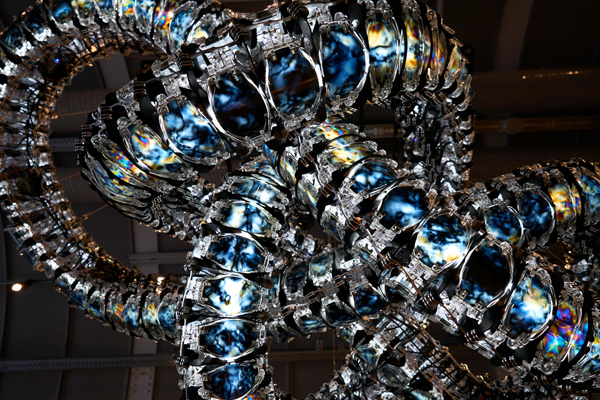
Installation "Exploring the Unknown" Y. Kim, Chroma VII (2023) © CERN Science Gateway (2023)/ M. Cavazza
|
|
|
Breaking the impasse:
towards new theoretical paradigms
|
|
|
Fundamental physics research is currently experiencing a time of great uncertainty. For over half a century, a solid and widely accepted theory – the so-called Standard Model of elementary particles – has guided the design of experiments, which have consistently confirmed its predictions with remarkable precision. However, we know that this theory does not provide the full picture and that answers to many important open questions may come from the discovery of new physics beyond the Standard Model: this calls for the development of new theoretical models and for experiments capable of opening up new scenarios. At the National Institute for Nuclear Physics, more than 1,500 researchers (members of the National Scientific Committee 4) explore the different lines of theoretical research: from field and string theory to elementary particle phenomenology, from hadronic and nuclear physics to mathematical methods, from astroparticle physics and cosmology to statistical and applied field theory. And on the hill of Arcetri, in Florence, where Galilei spent the last years of his life, INFN founded, in 2006, a National Centre for Advanced Studies in Theoretical Physics, the Galileo Galilei Institute (GGI), which hosts advanced workshops on theoretical physics with the aim of bringing together and inspire especially the younger generations of theoretical physicists. Since 2019, GGI has also been the venue for the award ceremony of the Galileo Galilei Medal, a major international prize granted by INFN every two years to up to three scientists who, over the previous 25 years, have achieved significant results in the theoretical physics of the fundamental interactions of elementary particles, including gravity and nuclear phenomena. In 2025, the prize was awarded to Leonard Susskind and Pierre Sikivie “for their work, which represents humanity’s enduring efforts to see and understand what may appear invisible, revealing in the process deep connections between the largest and smallest scales of Nature”. In this issue, we interviewed Leonard Susskind and revisited with him the years he has dedicated to theoretical physics, from string theory – of which he is considered one of the founding fathers – to his current thoughts on the future of physics.
|
|
|
Considered one of the fathers of string theory, Leonard Susskind was the first to provide a precise interpretation of the holographic principle and to introduce the idea of the string theory landscape. He is a Professor of Theoretical Physics at Stanford University, founder of the Stanford Institute for Theoretical Physics, and a member of several academies, including the US National Academy of Sciences. He was awarded the J. J. Sakurai Prize in 1998, the Oskar Klein Medal in 2018, the ICTP Dirac Medal in 2023 and the INFN Galileo Galilei Medal in 2025.
|
|
Interview with Leonard Susskind, considered one of the fathers of string theory and awarded the Galileo Galilei Medal 2025 by INFN for his fundamental contribution to the challenges that black holes pose to the classical and quantum nature of gravity
Let’s start with the basics: what is string theory?
Today, string theory is thought of as a theory about gravity and the most fundamental things at the smallest possible distances. But it didn’t start that way; it started as a theory of the subnuclear particles, the particles which make up the nucleus: protons, neutrons, and also mesons.
|
|
|
|
If you can't see the message below correctly, go here
If you receive this newsletter without subscribing, it means that you have been added to a list of recipients who may be interested, or you are an employee or affiliate of INFN.
If you no longer wish to receive this newsletter and are not an employee or affiliate of INFN, you can unsubscribe by sending an email to grafica@lists.infn.it.
Particle Chronicle © 2025 INFN
Newsletter Archive
EDITORIAL BOARD
Coordinator Martina Galli;
Project and contents Martina Bologna, Cecilia Collà Ruvolo, Eleonora Cossi,
Francesca Mazzotta, Antonella Varaschin;
Design and mailing coordinator Francesca Cuicchio; ICT service SSNN INFN
INFN - COMMUNICATIONS OFFICE - Piazza dei Caprettari, 70 - 00186 Roma
www.infn.it - news@lists.infn.it
|
|
|
|